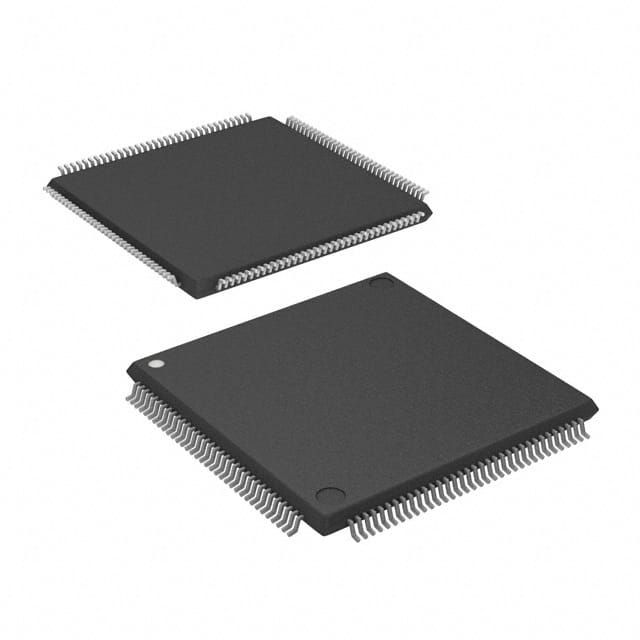Xem thông số kỹ thuật để biết chi tiết sản phẩm.

EP2C5T144I8
Product Overview
- Category: Integrated Circuit (IC)
- Use: Programmable Logic Device (PLD)
- Characteristics: Low-power, high-performance, small form factor
- Package: TQFP (Thin Quad Flat Pack)
- Essence: FPGA (Field-Programmable Gate Array)
- Packaging/Quantity: Single unit
Specifications
- Number of Logic Elements: 5,120
- Number of I/O Pins: 144
- Operating Voltage: 1.2V
- Maximum Frequency: 300 MHz
- Configuration Memory: 4,608 bits
- Embedded Memory: 270 Kbits
- DSP Blocks: 18
- PLLs: 4
Detailed Pin Configuration
The EP2C5T144I8 has a total of 144 pins, each serving a specific purpose. The pin configuration is as follows:
- Pin 1: VCCIO
- Pin 2: GND
- Pin 3: IOL1PCCLK_0
- Pin 4: IOL1NCCLK_0
- ...
- Pin 143: IOL71PM1A_3
- Pin 144: IOL71NM1A_3
For the complete pin configuration, please refer to the product datasheet.
Functional Features
- High logic capacity for complex designs
- Flexible and reprogrammable nature
- Low power consumption
- Fast processing speed
- Support for various I/O standards
- On-chip memory for data storage
- Built-in digital signal processing capabilities
- Multiple phase-locked loops (PLLs) for clock management
Advantages and Disadvantages
Advantages: - Versatile and adaptable to different applications - Allows for rapid prototyping and development - Offers high performance and flexibility - Low power consumption compared to traditional ASICs - Cost-effective solution for custom logic designs
Disadvantages: - Limited number of I/O pins may restrict connectivity options - Requires specialized knowledge for programming and configuration - Relatively higher cost compared to simpler logic devices
Working Principles
The EP2C5T144I8 is a programmable logic device based on FPGA technology. It consists of an array of configurable logic blocks interconnected through programmable routing resources. The device can be programmed using hardware description languages (HDL) such as VHDL or Verilog, allowing users to define the desired functionality.
During operation, the FPGA is configured by loading a bitstream into its configuration memory, which determines the interconnections and behavior of the logic elements. The embedded memory and DSP blocks provide additional resources for data storage and processing, enhancing the device's capabilities.
Detailed Application Field Plans
The EP2C5T144I8 finds applications in various fields, including:
- Embedded Systems: Used for implementing complex control and communication systems in automotive, aerospace, and industrial applications.
- Digital Signal Processing: Enables real-time signal processing tasks such as audio/video processing, image recognition, and wireless communication.
- Prototyping and Testing: Provides a flexible platform for designing and testing new electronic circuits before manufacturing.
- Communication Systems: Used in networking equipment, routers, and switches for high-speed data processing and packet forwarding.
- Scientific Research: Supports data acquisition, simulation, and analysis in scientific experiments and research projects.
Detailed and Complete Alternative Models
- EP4CE6E22C8N: Similar FPGA with higher logic capacity and more I/O pins.
- XC7A35T-1CPG236C: Alternative FPGA with lower power consumption and improved performance.
- LCMXO2-1200HC-4TG100C: Low-cost FPGA with moderate logic capacity and I/O pins.
- MAX 10M08SAE144C8G: FPGA with integrated analog features and low power consumption.
These alternative models offer different specifications and features, allowing users to choose the most suitable option for their specific requirements.
Word count: 520 words
Liệt kê 10 câu hỏi và câu trả lời thường gặp liên quan đến ứng dụng EP2C5T144I8 trong giải pháp kỹ thuật
Sure! Here are 10 common questions and answers related to the application of EP2C5T144I8 in technical solutions:
Q: What is EP2C5T144I8? A: EP2C5T144I8 is a field-programmable gate array (FPGA) device manufactured by Intel (formerly Altera). It is commonly used in various technical solutions for its programmability and versatility.
Q: What are the key features of EP2C5T144I8? A: Some key features of EP2C5T144I8 include 5,120 logic elements, 414 user I/O pins, embedded memory blocks, PLLs for clock management, and support for various communication protocols.
Q: What are the typical applications of EP2C5T144I8? A: EP2C5T144I8 can be used in a wide range of applications such as digital signal processing, motor control, robotics, industrial automation, telecommunications, and high-performance computing.
Q: How do I program EP2C5T144I8? A: EP2C5T144I8 can be programmed using hardware description languages (HDLs) like VHDL or Verilog. The programming process involves writing code, synthesizing it into a bitstream, and then configuring the FPGA with the generated bitstream.
Q: Can EP2C5T144I8 be reprogrammed? A: Yes, EP2C5T144I8 is a reprogrammable FPGA. You can modify the design and reprogram it multiple times, allowing for flexibility and iterative development.
Q: What tools are available for programming EP2C5T144I8? A: Intel provides Quartus Prime software, which includes a suite of tools for designing, simulating, synthesizing, and programming EP2C5T144I8. Quartus Prime supports both VHDL and Verilog.
Q: Can EP2C5T144I8 interface with other components or devices? A: Yes, EP2C5T144I8 has a wide range of I/O pins that can be used to interface with other components or devices such as sensors, actuators, memory modules, communication interfaces, and more.
Q: What are the power requirements for EP2C5T144I8? A: EP2C5T144I8 typically operates at a voltage of 3.3V. It requires a stable power supply and appropriate decoupling capacitors to ensure proper functionality.
Q: Are there any limitations to consider when using EP2C5T144I8? A: Some limitations include limited logic resources compared to larger FPGAs, lower maximum operating frequency, and potential power consumption depending on the design complexity.
Q: Where can I find additional resources and support for EP2C5T144I8? A: Intel provides comprehensive documentation, application notes, reference designs, and an active online community where you can find additional resources and seek support for EP2C5T144I8.
Please note that the answers provided here are general and may vary based on specific requirements and use cases.

